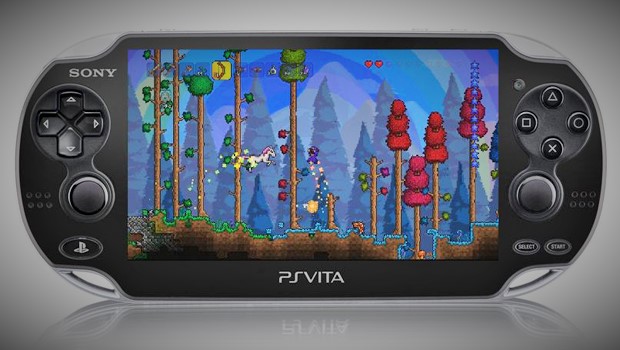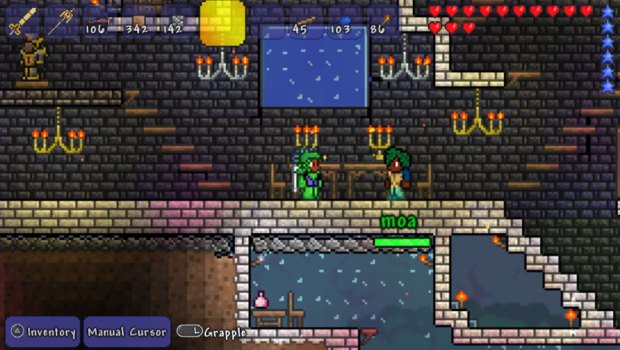Minecraft started a whole new genre when it launched. Since then, games have come out allowing you to craft and build your game world however you see fit. Each one has to have its own hook, and Terraria had the one that grabbed me by hand and drug me through it’s colorful, charming world of pixels. Terraria focused more on progressing through armor and weapons than simply building a world. In order to get better stuff, I had to beat bosses and advance the flow of the game. The retro-2D look certainly helped, because I never could adjust to Minecraft’s visuals.
Terraria launched on the PC over a year ago, and I dumped 30+ hours into learning the game. With as many things that there are to craft in that game, Terraria is a massive time sink, which ends up making it a great value for the money. Playing 30 or so hours with a mouse and keyboard, I wasn’t sure how the transition to console would be. About the time it launched on PS3 and Xbox 360, it was announced that Terraria was coming to Vita. I’m always looking for new Vita games so I waited.
More news came just before the December launch on the Vita that it would be cross-save and cross-play with the Playstation 3. That was the point that I bought the Playstation 3 version, to properly test those features and get a head start on my portable mining.
If for some reason this game has never grabbed your attention, and you have no idea what it’s about, let me explain. Terraria generates a random world and plops your character into it, with only a few necessary tools for survival. From there, it’s up to you on what you want to do next. Build a massive fort? Build a sky-bridge? Mine for resources to upgrade your tools? Terraria lets the player decide.
Things did carry over well to the console controller, taking only a little bit of time to get used to the adjustments. A lot of those changes made the leap to Vita, too. To speed things up, there is a “smart cursor” and a “manual cursor”. For general digging and roaming around, I played with the “smart cursor”. When precision was needed, though, the “manual cursor” made digging around lava or placing bricks when building my homes simple and effortless.
Being able to access various things on the fly is essential, especially later in the game. Terraria allows players to tie items to the D-pad, so using a potion was as simple as pressing Down on the D-pad for me. Those items don’t have to be in your limited main item section. Switching between those main items along the top of the screen is a little more difficult on the Vita, however. On the console, you hit the bottom triggers to move through the line. The Vita, missing the triggers, uses the touch screen. There’s an option of tapping the item itself, which is a little bit of a reach when in a pinch, or tapping the right or left side of the screen to switch items in said-direction. The problem with that is if I was in a bind, sometimes the taps wouldn’t register properly.
Content-wise, there are two versions of Terraria available, the PC-version which has the most content and the console version, which isn’t quite up to date yet. Since the Vita version has a cross-save function, the content is the same on the Vita as it is on the PS3. When referencing the Wikia for Terraria, the new content (in version 1.2) appears to double the available things to build and do in Terraria, which is sadly missing at the moment. All of that content is coming, though, which will be a welcome patch-in.
Terraria on the Vita, though, has been a welcome addition to my portable console. Moving my save from the Playstation 3 to the Vita was a seamless ordeal, and I’ve spent more time playing my Vita in the past few weeks because of it. My worries of the small screen and controls were quickly put to rest after just a little bit of time adjusting to the changes, and I can’t recommend it more to gamers who are looking for a new Vita game to play.
This review was written with review code provided by the publisher. For more on our review policies, please read here.


